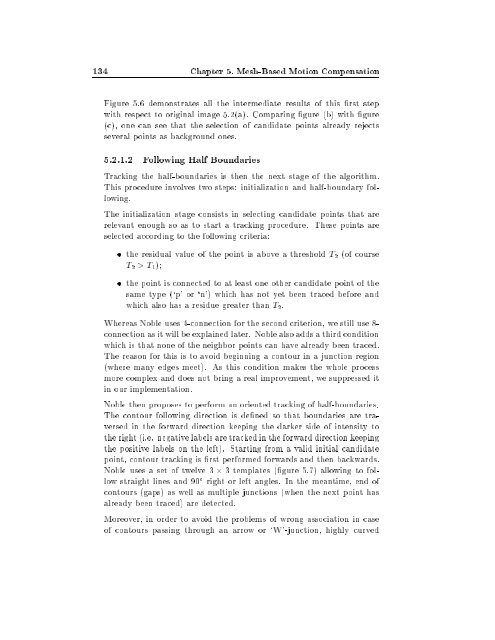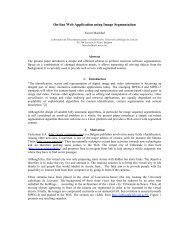motion estimation and compensation for very low bitrate video coding
motion estimation and compensation for very low bitrate video coding
motion estimation and compensation for very low bitrate video coding
You also want an ePaper? Increase the reach of your titles
YUMPU automatically turns print PDFs into web optimized ePapers that Google loves.
134 Chapter 5. Mesh-Based Motion Compensation<br />
Figure 5.6 demonstrates all the intermediate results of this rst step<br />
with respect to original image 5.2(a). Comparing gure (b) with gure<br />
(c), one can see that the selection of c<strong>and</strong>idate points already rejects<br />
several points as background ones.<br />
5.2.1.2 Fol<strong>low</strong>ing Half Boundaries<br />
Tracking the half-boundaries is then the next stage of the algorithm.<br />
This procedure involves two steps: initialization <strong>and</strong> half-boundary fol<strong>low</strong>ing.<br />
The initialization stage consists in selecting c<strong>and</strong>idate points that are<br />
relevant enough so as to start a tracking procedure. These points are<br />
selected according to the fol<strong>low</strong>ing criteria:<br />
the residual value of the point isabove a threshold T 2 (of course<br />
T 2 >T 1);<br />
the point is connected to at least one other c<strong>and</strong>idate point of the<br />
same type (`p' or `n') which has not yet been traced be<strong>for</strong>e <strong>and</strong><br />
which also has a residue greater than T 2.<br />
Whereas Noble uses 4-connection <strong>for</strong> the second criterion, we still use 8connection<br />
as it will be explained later. Noble also adds a third condition<br />
which is that none of the neighbor points can have already been traced.<br />
The reason <strong>for</strong> this is to avoid beginning a contour in a junction region<br />
(where many edges meet). As this condition makes the whole process<br />
more complex <strong>and</strong> does not bring a real improvement, we suppressed it<br />
in our implementation.<br />
Noble then proposes to per<strong>for</strong>m an oriented tracking of half-boundaries.<br />
The contour fol<strong>low</strong>ing direction is de ned so that boundaries are traversed<br />
in the <strong>for</strong>ward direction keeping the darker side of intensity to<br />
the right (i.e. negative labels are tracked in the <strong>for</strong>ward direction keeping<br />
the positive labels on the left). Starting from a valid initial c<strong>and</strong>idate<br />
point, contour tracking is rst per<strong>for</strong>med <strong>for</strong>wards <strong>and</strong> then backwards.<br />
Noble uses a set of twelve 3 3 templates ( gure 5.7) al<strong>low</strong>ing to fol<strong>low</strong><br />
straight lines <strong>and</strong> 90 right or left angles. In the meantime, end of<br />
contours (gaps) as well as multiple junctions (when the next point has<br />
already been traced) are detected.<br />
Moreover, in order to avoid the problems of wrong association in case<br />
of contours passing through an arrow or `W'-junction, highly curved





